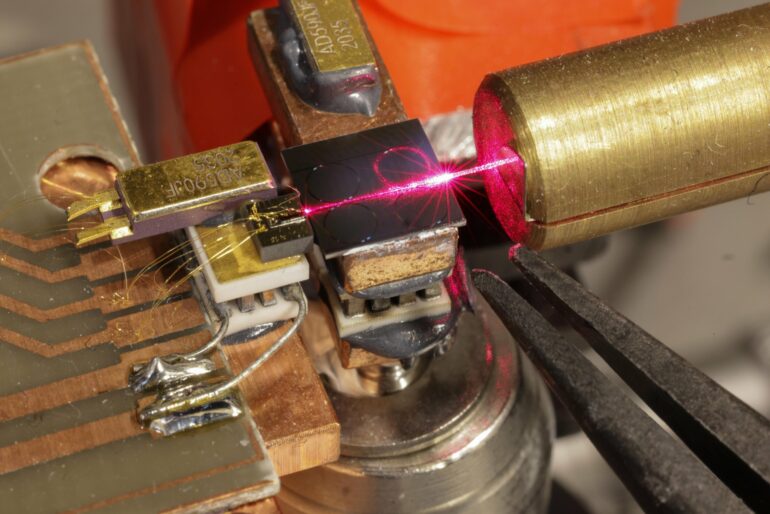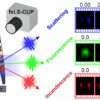The team at EPFL’s Photonic Systems Laboratory (PHOSL) has developed a chip-scale laser source that enhances the performance of semiconductor lasers while enabling the generation of shorter wavelengths.
This pioneering work, led by Professor Camille Brès and postdoctoral researcher Marco Clementi from EPFL’s School of Engineering represents a significant advance in the field of photonics, with implications for telecommunications, metrology, and other high-precision applications.
The study, published in the journal Light: Science & Applications, reveals how the PHOSL researchers, in collaboration with the Laboratory of Photonics and Quantum Measurements, have successfully integrated semiconductor lasers with silicon nitride photonic circuits containing microresonators. This integration results in a hybrid device that emits highly uniform and precise light in both near-infrared and visible ranges, filling a technological gap that has long challenged the industry.
“Semiconductor lasers are ubiquitous in modern technology, found in everything from smartphones to fiber optic communications. However, their potential has been limited by a lack of coherence and the inability to generate visible light efficiently,” explains Professor Brès. “Our work not only improves the coherence of these lasers but also shifts their output towards the visible spectrum, opening up new avenues for their use.”
Coherence, in this context, refers to the uniformity of the phases of the light waves emitted by the laser. High coherence means the light waves are synchronized, leading to a beam with a very precise color or frequency. This property is crucial for applications where precision and stability of the laser beam are paramount, such as timekeeping and precision sensing.
Increased accuracy and improved functionality
The team’s approach involves coupling commercially available semiconductor lasers with a silicon nitride chip. This tiny chip is created with industry-standard, cost-efficient CMOS technology. Thanks to the material’s exceptional low-loss properties, there is little to no light that is absorbed or escapes.
The light from the semiconductor laser flows through microscopic waveguides into extremely small cavities, where the beam is trapped. These cavities, called micro-ring resonators, are intricately designed to resonate at specific frequencies, selectively amplifying the desired wavelengths while attenuating others, thereby achieving enhanced coherence in the emitted light.
The other significant achievement is the hybrid system’s ability to double the frequency of the light coming from the commercial semiconductor laser— enabling a shift from the near-infrared spectrum to the visible light spectrum.
The relationship between frequency and wavelength is inversely proportional, meaning that if the frequency is doubled, the wavelength is reduced by half. While the near-infrared spectrum is exploited for telecommunications, higher frequencies are essential for building smaller, more efficient devices where shorter wavelengths are needed, such as in atomic clocks and medical devices.
These shorter wavelengths are achieved when the trapped light in the cavity undergoes a process called all-optical poling, which induces what is known as second-order nonlinearity in the silicon nitride. Nonlinearity in this context means that there is a significant shift, a jump in magnitude, in the light’s behavior that is not directly proportional to its frequency arising from its interaction with the material.
Silicon nitride does not normally incur this specific second-order nonlinear effect, and the team performed an elegant engineering feat to induce it: The system takes advantage of the light’s capacity when resonating within the cavity to produce an electromagnetic wave that provokes the nonlinear properties in the material.
An enabling technology for future applications
“We are not just improving existing technology but also pushing the boundaries of what’s possible with semiconductor lasers,” says Marco Clementi, who played a key role in the project. “By bridging the gap between telecom and visible wavelengths, we’re opening the door to new applications in fields like biomedical imaging and precision timekeeping.”
One of the most promising applications of this technology is in metrology, particularly in the development of compact atomic clocks. The history of navigational advancements hinges on the portability of accurate timepieces—from determining longitude at sea in the 16th Century to ensuring the accurate navigation of space missions and achieving better geo-localization today.
“This significant advancement lays the groundwork for future technologies, some of which are yet to be conceived,” notes Clementi.
The team’s deep understanding of photonics and material science will potentially lead to smaller and lighter devices and lower the energy consumption and production costs of lasers. Their ability to take a fundamental scientific concept and translate it into a practical application using industry-standard fabrication underscores the potential of solving complex technological challenges that can lead to unforeseen advances.
More information:
Marco Clementi et al, A chip-scale second-harmonic source via self-injection-locked all-optical poling, Light: Science & Applications (2023). DOI: 10.1038/s41377-023-01329-6
Provided by
Ecole Polytechnique Federale de Lausanne
Citation:
A micro-ring resonator with big potential: Hybrid device significantly improves laser technology (2023, December 8)



